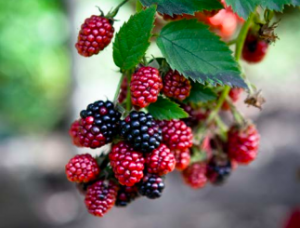RUBUS (Brambles) 2020 Herb of the Year Red Raspberry, Black Raspberry, Blackberry & Wineberry
Article by Dana Weinberg, UConn Extension Advanced Master Gardener
Since 1991, the International Herb Society has chosen an Herb of the Year. This year’s choice is the genus Rubus. The name comes from the Latin word ‘ruber’ meaning red. Indigenous to 6 continents and readily hybridized, you can count up to 700 different species within the genus. It’s mid summer and the raspberries, wineberries and even some blackberries are bearing their delicious fruit. What a great time to explore some of the commonalities and differences in this wideranging genus!
A member of the Rosaceae family, all Rubus species bear 5 petalled flowers, like a wild rose. These petals are usually white, but sometimes pink. Each flower has several pistils. Each flower has numerous pollen-laden stamens which attract insects, but many Rubus species are also self-fertile with the ability to set seed on their own. All flower parts are attached to a central coneshaped receptacle (torus). Rubus fruit is an aggregate of small drupelets (individual fleshy fruits surrounding a single seed) attached to the torus.
Members of this genus thrive in well drained, humus rich soils in full sun to part shade. Their water requirement is modest. Rubus stems are called canes. Canes can be green to somewhat woody and are usually covered with bristles, prickles and/or gland-tipped hairs. They spread by seed, tip rooting, or suckering from stolon runners or rhizomes, depending on species.

Rubus root stock is perennial, but the canes are biennial. With the exception of some special cultivars, first year canes (primocanes) yield flowers and fruit only during their second season (floricanes), then die. The floricanes are then replaced by new primocanes the following year. Canes can vary in length, depending on type. In the wild, canes tend to bend and arc. In cultivation, canes are commonly pruned and trellised.
Rubus plants have been used since antiquity for food and medicine. Stems, roots, flowers and leaves have been used in infusions, plasters and extractions to treat a wide range of maladies. These include treatments for diarrhea, nausea, stomach ailments, shingles and fevers, as an external wash for wounds, as an antivenom for snakebites, to strengthen gums, to reduce eye inflammation, to cool rashes and as a hair dye. Rubus fruits are full of fiber, antioxidants and vitamins and are delicious to eat.